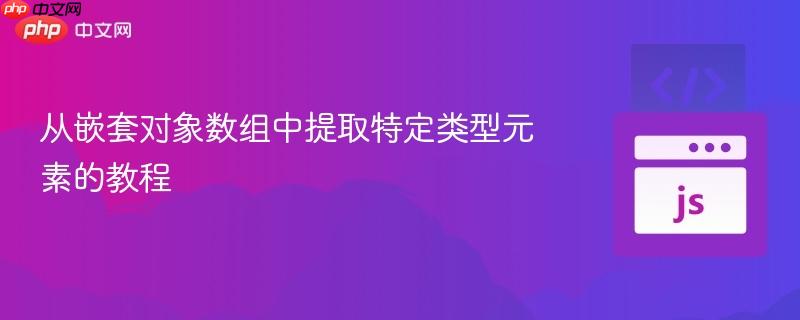
本文深入探讨了如何在深度嵌套的javascript对象数组中高效地查找并提取具有特定`type`属性的对象。我们将详细介绍两种主要方法:基于栈的迭代遍历和递归遍历,并提供迭代方法的代码示例和实现细节,帮助开发者处理复杂的json数据结构,确保能够准确、全面地筛选出所需数据。
在现代Web应用开发中,我们经常会遇到结构复杂、层级深度不定的JSON或对象数组。例如,一个UI组件树、文档结构或配置对象,其内部可能包含多层嵌套的items数组。在这种数据结构中,如果需要找出所有具有特定属性(如type: "text")的对象,直接的filter或map方法将无法满足需求,因为它们通常只处理第一层数组。此时,我们需要更强大的遍历策略来深入到所有嵌套层级。
为了有效地遍历任意深度的嵌套结构,并提取满足条件的对象,我们可以采用基于栈(Stack)的迭代方法。这种方法本质上是一种深度优先搜索(DFS)策略,它能够确保访问到所有层级的元素。
以下是使用TypeScript实现此迭代方法的代码:
interface Item {
uid: string;
type: string;
items?: Item[]; // 可选的嵌套子元素数组
// ... 其他属性
}
const data: Item[] = [
{
"index": 3,
"uid": "188960ecb29_00562b0c",
"x": 18.651406278454424,
"y": 44.14920570161545,
"width": 180.14783325004774,
"height": 53.336747638012184,
"items": [
{
"uid": "18895f59b1a_2c5a5c7a",
"locked": false,
"rotation": 0,
"type": "text",
"text": ["abc"],
"x": 154.37927087307924,
"y": 0,
"width": 25.768562376968507,
"height": 20.90412770669292,
"sampleTextChanged": true,
"fontSize": 15.590551181102365,
"fontFamily": "NimbusSansME",
"textBold": false,
"textItalic": false,
"textUnderline": false,
"textAlignment": "TEXT_ALIGN_LEFT",
"textLetterSpacing": 0,
"color": { "red": 0, "green": 0, "blue": 0, "__class__": "RGBAColor", "alpha": 1 },
"placeholderText": ["Text"],
"isPlaceholderTextActive": false,
"translationKey": "",
"newPathCalculation": true,
"shadow": { "blur": 0, "color": "{\"red\":255,\"green\":255,\"blue\":255,\"transparent\":0}", "coords": { "x": 0, "y": 0 }, "distance": 0, "opacity": 1 },
"index": 0,
"originalTextItem": ["abc"],
"originalXcoords": [[0, 8.25203001968504, 17.47085691437008, 25.768562376968507]]
},
{
"index": 1,
"uid": "1889607cfdf_091e59ca",
"x": 0,
"y": 32.432619931319266,
"width": 22.175427534448822,
"height": 20.90412770669292,
"items": [
{
"uid": "18895ecc7c7_2d5440b6",
"locked": false,
"rotation": 0,
"type": "text",
"text": ["xyz"],
"x": 0,
"y": 0,
"width": 22.175427534448822,
"height": 20.90412770669292,
"sampleTextChanged": true,
"fontSize": 15.590551181102365,
"fontFamily": "NimbusSansME",
"textBold": false,
"textItalic": false,
"textUnderline": false,
"textAlignment": "TEXT_ALIGN_LEFT",
"textLetterSpacing": 0,
"color": { "red": 0, "green": 0, "blue": 0, "__class__": "RGBAColor", "alpha": 1 },
"placeholderText": ["Text"],
"isPlaceholderTextActive": false,
"translationKey": "",
"newPathCalculation": true,
"shadow": { "blur": 0, "color": "{\"red\":255,\"green\":255,\"blue\":255,\"transparent\":0}", "coords": { "x": 0, "y": 0 }, "distance": 0, "opacity": 1 },
"index": 0,
"originalTextItem": ["xyz"],
"originalXcoords": [[0, 7.54406065452756, 14.95870755413386, 22.175427534448822]]
}
],
"type": "group",
"rotation": 0
},
{
"index": 2,
"uid": "188960e945c_35ab99fa",
"x": 44.108363106593984,
"y": 15.56765756703328,
"width": 56.72123163199389,
"height": 35.17448047647336,
"items": [
{
"uid": "18896072844_1298562b",
"locked": false,
"rotation": 0,
"type": "text",
"text": ["group"],
"x": 15.567657567033265,
"y": 14.270352769780445,
"width": 41.15357406496064,
"height": 20.90412770669292,
"sampleTextChanged": true,
"fontSize": 15.590551181102365,
"fontFamily": "NimbusSansME",
"textBold": false,
"textItalic": false,
"textUnderline": false,
"textAlignment": "TEXT_ALIGN_LEFT",
"textLetterSpacing": 0,
"color": { "red": 0, "green": 0, "blue": 0, "__class__": "RGBAColor", "alpha": 1 },
"placeholderText": ["Text"],
"isPlaceholderTextActive": false,
"translationKey": "",
"newPathCalculation": true,
"shadow": { "blur": 0, "color": "{\"red\":255,\"green\":255,\"blue\":255,\"transparent\":0}", "coords": { "x": 0, "y": 0 }, "distance": 0, "opacity": 1 },
"originalTextItem": ["group"],
"originalXcoords": [[0, 9.013287401574805, 14.342089074803152, 23.241187869094492, 31.9195220226378, 41.15357406496064]],
"index": 2
},
{
"index": 3,
"uid": "188960e5f49_2341c362",
"x": 0,
"y": 0,
"width": 29.803226500984252,
"height": 20.90412770669292,
"items": [
{
"uid": "188958badfe_3a73220b",
"locked": false,
"rotation": 0,
"type": "text",
"text": ["Text"],
"x": 0,
"y": 0,
"width": 29.803226500984255,
"height": 20.90412770669292,
"sampleTextChanged": false,
"fontSize": 15.590551181102365,
"fontFamily": "NimbusSansME",
"textBold": false,
"textItalic": false,
"textUnderline": false,
"textAlignment": "TEXT_ALIGN_LEFT",
"textLetterSpacing": 0,
"color": { "red": 0, "green": 0, "blue": 0, "__class__": "RGBAColor", "alpha": 1 },
"placeholderText": ["Text"],
"isPlaceholderTextActive": false,
"translationKey": "",
"newPathCalculation": true,
"shadow": { "blur": 0, "color": "{\"red\":255,\"green\":255,\"blue\":255,\"transparent\":0}", "coords": { "x": 0, "y": 0 }, "distance": 0, "opacity": 1 },
"index": 0,
"istextCircularMode": false,
"originalTextItem": ["Text"],
"originalXcoords": [[0, 9.119863435039372, 17.60027066929134, 25.1443313238189, 29.803226500984255]]
}
],
"type": "group",
"rotation": 0
}
],
"type": "group",
"rotation": 0
}
],
"type": "group",
"rotation": 0
}
];
const getSpecificType = (targetType: string): Item[] => {
const result: Item[] = [];
// 使用扩展运算符将初始数据复制到栈中
const stack: Item[] = [...data];
while (stack.length > 0) {
const current = stack.pop(); // 从栈顶弹出一个元素
if (!current) continue; // 避免空值
// 检查当前元素的类型是否匹配
if (current.type === targetType) {
result.push(current);
}
// 如果当前元素有子元素(items数组),则将其所有子元素推入栈中
// 使用 ?? [] 确保即使 items 为 undefined 或 null 也能安全地扩展空数组
if (current.items && current.items.length > 0) {
stack.push(...current.items);
}
}
return result;
};
// 示例调用
const textElements = getSpecificType("text");
console.log(textElements);除了迭代方法,递归也是处理嵌套数据结构的经典方式。递归方法通过函数自身调用来遍历子层级。
递归方法的思路是定义一个函数,该函数接收一个对象或对象数组。对于每个对象:
由于递归在概念上与迭代(使用显式栈)相似,且迭代方法在JavaScript环境中对深层嵌套的健壮性更好,因此在大多数实际场景中,迭代方法是更推荐的选择。
从嵌套对象数组中提取特定类型元素是处理复杂数据结构的常见需求。无论是采用基于栈的迭代方法还是递归方法,核心都在于实现深度优先遍历。
在实际开发中,为了提高代码的健壮性和可维护性,建议:
掌握这些遍历和筛选技巧,将使您在处理各种复杂JSON和对象数据时更加得心应手。
以上就是从嵌套对象数组中提取特定类型元素的教程的详细内容,更多请关注php中文网其它相关文章!

每个人都需要一台速度更快、更稳定的 PC。随着时间的推移,垃圾文件、旧注册表数据和不必要的后台进程会占用资源并降低性能。幸运的是,许多工具可以让 Windows 保持平稳运行。

Copyright 2014-2025 https://www.php.cn/ All Rights Reserved | php.cn | 湘ICP备2023035733号